Barefoot Shoes Market Research, 2031
The global barefoot shoes market was valued at $471.1 million in 2021, and is projected to reach $788.7 million by 2031, growing at a CAGR of 5.3% from 2022 to 2031. A barefoot shoe has a zero heel-to-toe drop, which means the entire foot is on the same level as the ground same as barefoot. These shoes allow the foot to land on the ground almost as if one is running barefoot: they do little more than provide grip and protect feet against harmful objects on the ground. Some are designed to help the consumers transition from heel-first running to barefoot-style running. The shoes were introduced with the aim to strengthen and let the foot grow at an actual pace.
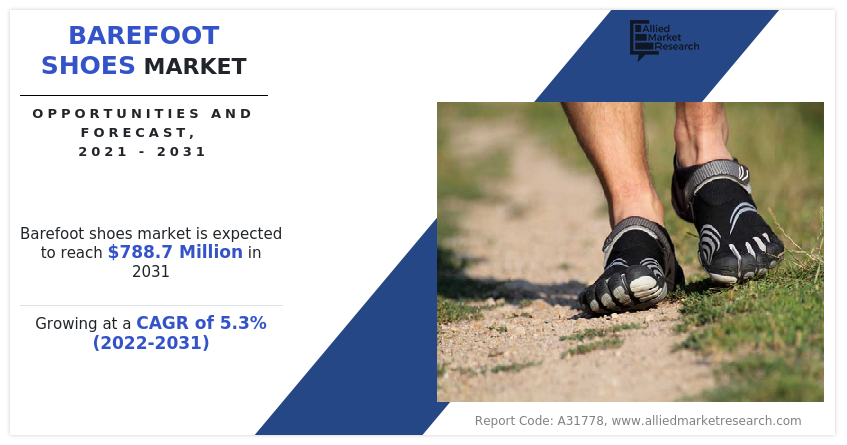
A minimalist type of shoe could be beneficial for an experienced runner or active walker who wants to take it to the next level. Large population size, coupled with a rise in disposable income is among the major factors that boost demand for high-end footwear in developing markets.
An increase in sales through online channels, innovative product launches, attractive marketing, and promotional strategies are other factors are expected to propel the barefoot shoes market demand. An increase in environmental concerns and a rise in the prices of raw materials are the major challenges for players operating in the barefoot shoes market. However, the market is anticipated to unfold attractive business opportunities, owing to changes in consumer lifestyles and an increase in penetration of online retailing. Consumers are becoming more health conscious due to work-related stress and lifestyle disorders. Thus, the increase in the number of health-conscious consumers has created a strong demand for athletic sportswear and footwear, which, in turn, augments the growth of the overall barefoot shoes market.
Moreover, the rise in the trend of fashionable sports apparel propels the growth of the barefoot shoes market. Furthermore, continuous innovations in sportswear and footwear notably contribute to the growth of the barefoot shoes market. However, an increase in the inclination of kids toward indoor leisure activities is expected to hamper the growth of the market during the forecast period. On the contrary, an increase in the participation of women in sports is anticipated to offer remunerative opportunities for the expansion of the barefoot shoes market in the future.
The availability of fake and low-priced products restricts the growth of the barefoot shoes market. Sportswear and footwear by renowned brands have a high price range, which is not affordable for lower-income groups. Hence, local suppliers design the same style of products at comparatively lower costs. Such products are of low quality and hamper the brand image of forerunners in the market, thereby limiting sales of original products. The availability of counterfeit or low-quality sportswear and footwear restricts sales of branded products, thus threatening the barefoot shoes market growth.
Hectic work schedules and growth in the number of health-related issues are encouraging people to adopt daily exercise routines, such as jogging, gym, and yoga. This has increased demand for the barefoot shoes. Moreover, the rising obesity rate among the global population is also expected to increase the population’s concern about fitness activity. According to the World Health Organization (WHO), worldwide obesity has nearly tripled since 1975. This huge rise in the population suffering from obesity is grabbing consumers’ attention toward fitness which is expected to boost the growth of the barefoot shoes industry.
The initiative being taken by the government towards the participation of youth in sports is expected to surge the growth of the barefoot shoes market. For instance, the National Youth Sports Strategy aims to unite U.S. youth sports culture around a shared vision that one day all youth of the country will have the opportunity, motivation, and access to play sports. Along with these the rising government investments in the Olympics and other sports events are also expected to boost the growth of the barefoot shoes market size.
Rubber, leather, and mesh are the main raw materials, used for the manufacturing of barefoot shoes. There has been a continuous rise in prices of raw materials such as rubber and synthetic foam in past few years. The prices of raw materials directly affect the production cost of products, thereby leading to an increase in the market price of finished products. This acts as a restraint for the barefoot shoes industry.
Change in consumer lifestyle in developing countries due to urbanization has led to an increase in demand for new and fashionable products. This provides manufacturers with an opportunity to launch new and innovative products and increase their barefoot shoes market size. For instance, in India, urbanization is taking place at a dramatic pace and is influencing the lifestyle and buying behavior of consumers. The increase in the number of people involved in gyms, jogging, and other such activities has increased sales of barefoot shoes in India.
E-commerce is expected to act as an opportunity for market players in the coming years. E-commerce has a large number of benefits, including speed of access and a wider selection of goods and services. E-commerce is gaining traction in most countries as demand for online goods is increasing. The rise in penetration of the internet and smartphones has been the major growth factor for e-commerce. Moreover, apart from the outlets, e-commerce has become a necessity for players to increase their sales and consumer base globally.
Researchers from a university in Johannesburg, South Africa compared modern humans from different populations to the feet of 2,000-year-old skeletons and concluded that, before shoes, people had healthier stronger feet. Another study compared the feet of South African and German children and found those who regularly went barefoot had healthier feet (higher overall arches and straighter big toes) than the (European) shoe-wearers. The regularly barefoot also presented with fewer foot characteristics like flat feet and deformed big toes and bunions, as well as more flexible, pliable feet. Such advantages of barefoot shoes are attracting consumers’ attention towards it which is expected to boost the growth of the barefoot shoes market.
The barefoot shoes market is segmented on the basis of end-user, shoe closure type, distribution channel, and region. By end-user, the market is categorized into men, women, and kids. By shoe closure type, the barefoot shoes market is classified into buckle, lace-up, zipper, and others. By distribution channel, the market is segmented into hypermarkets, specialty stores, brand outlets, and e-commerce. Region-wise, the barefoot shoes market is analyzed across North America, Europe, Asia-Pacific, and LAMEA.
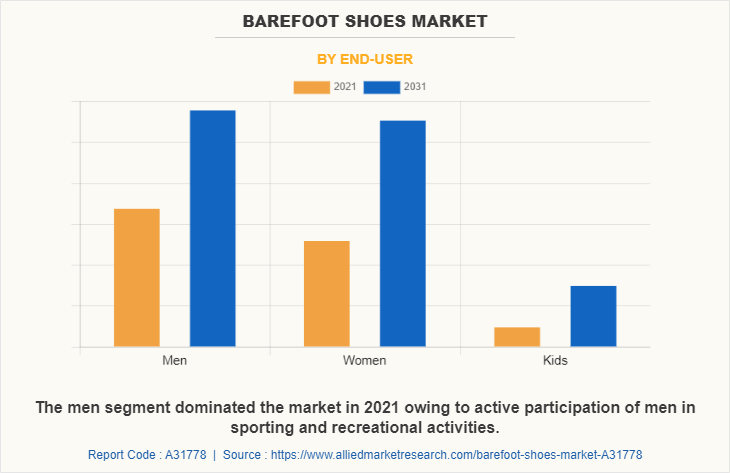
On the basis of end-user, the barefoot shoes market is further segmented into men, women, and kids. The men segment dominated the global market and is expected to retain its dominance during the barefoot shoes market forecast period. Men actively participate in sporting and recreational activities. A consistent increase in the participation of men in outdoor sports is expected to support the growth of the barefoot shoes market size during the forecast period.
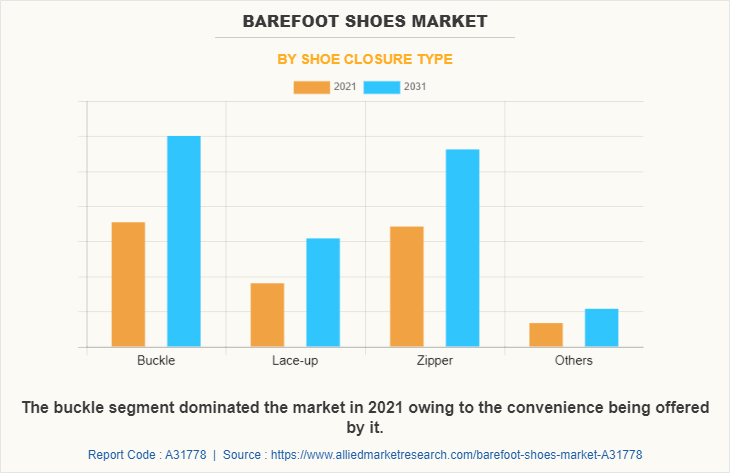
On the basis of shoe closure type, the barefoot shoes market is further bifurcated into buckle, lace-up, zipper, and others. The buckle segment constitutes a major barefoot shoes market share. Buckles as shoe closures were initially used by Roman soldiers to fasten armor and for decorative purposes too. Over the years, buckles have come in and out of fashion. Still one can see buckles on shoes; however, they’re usually used with a strip of leather.
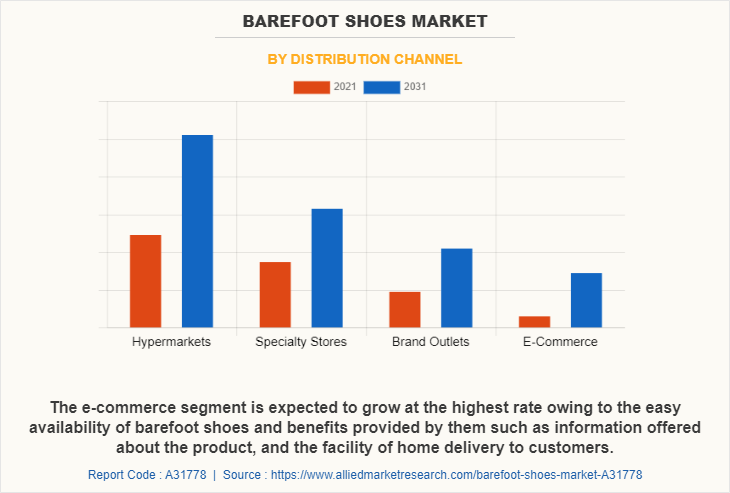
On the basis of distribution channels, the barefoot shoes market is categorized into hypermarkets, specialty stores, brand outlets, and e-commerce. The hypermarket segment is projected to dominate the market accounting for more than 38.71% share in 2031 growing at a significant CAGR of 5.9% from 2022 to 2031. An increase in the availability of barefoot shoes through hypermarkets along with specialists’ advice is expected to boost sales through these distribution channels.
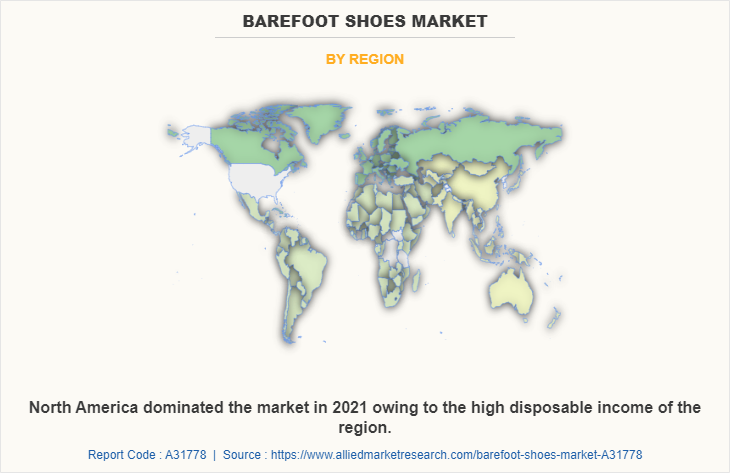
For the barefoot shoes market analysis, on the basis of region, the market is segmented into North America (the U.S., Canada, and Mexico), Europe (Germany, France, Spain, Italy, and the Rest of Europe), Asia-Pacific (China, Japan, India, Australia, New Zealand, and the rest of Asia-Pacific), and LAMEA (Brazil, Argentina, Saudi Arabia, South Africa, and the rest of LAMEA). North America dominated the market in 2021. Asia-Pacific is expected to witness the highest growth owing to the rise in consciousness about their health and fitness in countries such as India, China, and Japan, which propels the growth of the barefoot shoes market in these regions.
The key players operating in the barefoot shoes market have adopted product launch, business expansion, and merger & acquisition as their key strategies to expand their market share, increase profitability, and remain competitive in the market. Leading players analyzed in the barefoot shoes market analysis include Vivobarefoot Limited, Adidas AG, New Balance Athletics, Inc., Asics Corporation, Vibram S.p.A, Softstar Shoes, Lems Shoes, Wolverine Worldwide, Inc., Inov-8 Inc, Puma SE, KINEYATABI CO LTD., Body Glove, Nike Inc., Tadeevo, VF Corporation and Feel The World, Inc.
Key Benefits For Stakeholders
- This report provides a quantitative analysis of the market segments, current trends, estimations, and dynamics of the barefoot shoes market analysis from 2021 to 2031 to identify the prevailing barefoot shoes market opportunities.
- The market research is offered along with information related to key drivers, restraints, and opportunities.
- Porter's five forces analysis highlights the potency of buyers and suppliers to enable stakeholders make profit-oriented business decisions and strengthen their supplier-buyer network.
- In-depth analysis of the barefoot shoes market segmentation assists to determine the prevailing market opportunities.
- Major countries in each region are mapped according to their revenue contribution to the global barefoot shoes market.
- Market player positioning facilitates benchmarking and provides a clear understanding of the present position of the market players.
- The report includes the analysis of the regional as well as global barefoot shoes market trends, key players, market segments, application areas, and market growth strategies.
Barefoot shoes Market Report Highlights
| Aspects | Details |
| Market Size By 2031 | USD 788.7 million |
| Growth Rate | CAGR of 5.3% |
| Forecast period | 2021 - 2031 |
| Report Pages | 289 |
| By End-User |
|
| By Shoe Closure Type |
|
| By Distribution Channel |
|
| By Region |
|
| Key Market Players | Tadeevo, Vivobarefoot Limited, KINEYATABI CO LTD., Puma SE, New Balance Athletics, Inc., Nike Inc., Wolverine World Wide, Inc., Softstar Shoes., Adidas AG, Lems Shoes, Vibram S.p.A, Feel The World, Inc., Inov-8 Inc, Body Glove., VF Corporation |
Analyst Review
According to the CXOs, an increase in health consciousness is projected to drive the demand for the barefoot shoes market. However, the high price of the product is anticipated to hamper the market growth during the forecast period.
CXOs further added that the rise in the interest toward athletics and adventure sports is anticipated to propel the growth of the market and the increase in disposable income coupled with changes in the lifestyle of consumers are expected to propel the growth of the barefoot shoes market.
The barefoot shoes market was valued at $471.09 million in 2021 and is estimated to reach $788.70 million by 2031.
The global barefoot shoes market registered a CAGR of 5.3% from 2022 to 2031.
Raise the query and paste the link of the specific report and our sales executive will revert with the sample.
The forecast period in the barefoot shoes market report is from 2022 to 2031.
The major players operating in the global barefoot shoes industry are Vivobarefoot Limited, Adidas AG, New Balance Athletics, Inc., Asics Corporation, Vibram S.p.A, Softstar Shoes, Lems Shoes, Wolverine Worldwide, Inc., Inov-8 Inc, Puma SE, KINEYATABI CO LTD., Body Glove, Nike Inc., Tadeevo, VF Corporation and Feel The World, Inc.. These market players are constantly engaged in various developmental strategies such as acquisitions, mergers, and product launches to exploit barefoot shoes market opportunities and gain market share.
The barefoot shoes market is segmented on the basis of end-user, shoe closure type, distribution channel, and region.
The COVID-19 pandemic had a negative impact on the barefoot shoes market since no sport activity resulted in the downfall of barefoot shoes buying and selling activities. However, online stores were supplying footwear to the public but it was of no use as people were forced to stay at home.
North America will dominate the barefoot shoes market by the end of 2031.
Loading Table Of Content...


